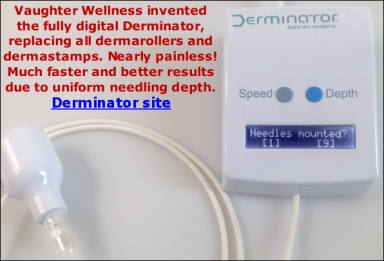Yes, the skin on the arms is thinner than that on the legs.
It is impossible to sell a universal length needle that fits every skin condition and every part of the body, because firstly: Skin thickness varies significantly, depending on what part of the body it covers. The thinnest skin is on the eyelids (0.5 mm or less) the thickest is on the soles of the feet. The back and the buttocks have thick skin as well.
Secondly, it also varies individually. We have customers that roll their face with a 2 mm roller and they get no pinpoint bleeding and we have customers that roll their face with 0.5 mm and they get quite some pinpoint bleeding. And men usually have thicker skin than women.
I am really sorry it caused you bruising on your arms but the good news is that the release of blood may infact improve your stretchmarks. You caused a microwound to the skin, the body will fix it and fill the microwound with new skin. That is the principle behind dermarolling and in fact, the literature suggests that blood plasma helps with this process. Do not get me wrong. You do not have to cause bleeding in order to improve the stretchmarks but apart from the cosmetic problem of being bruised, you do not have to worry too much about it either. Some surgeons even use dermarollers with 3 mm needles. We can even order those for our customers.
You should not needle deeper than occasional pinpoint bleeding but the line between pinpoint bleeding and getting bruises is a fine line and it is difficult to guess.the best is to try a small patch first. Our needles have a "safety stop" at around 2 mm, but some needles are longer than others, so that you can choose which one suits a particular skin area best. You should not always put the needle in until it can't go any further - not on thin skin in any case.
The skin consists of the epidermis, the dermis and the subdermis (fat layer).
The epidermis has no blood supply at all. If you get pinpoint bleeding it means you reached the dermis. The dermis has irregular tiny blood vessels and the deeper you go into the dermis, the more blood vessels there are. If you reach the deeper parts of the dermis where there are many bloodvessels, you could end up with bruises.
Stretchmarks reside in the dermis. As said, skin thickness is not the same all over the body, unfortunately.
You can adjust the needle length with a toothpick, so that you can let them penetrate only a mm, for example:
https://http://forums.owndoc.com/dermarolling-microneedling/Adjusting-the-length-of-the-single-needle The "toothpick solution" is not ideal but it's the best we found so far. So, next time when you needle your arms, use a toothpick to make it shorter.
We are trying to improve our products to our customers' needs and I hope we can find a better solution. As I explained, it is impossible to sell a universal length that would be perfect for every condition and every customer. We still haven't found a needle manufacturer that can produce the perfect needle in a range of perfectly accurate lengths in the mm range. I hope next year we will have found such a supplier, but the current needles are in fact very good already, as long as you are aware that for some skin, they are a bit too long and should be either not pushed in to the hilt, or shortened with a taped toothpick to the shaft.
Regarding bruises: You can use a cream containing heparin (available OTC in pharmacies), which will make the bruises disappear quicker. Do not apply Heparin cream immediately after needling (do not use it on "open" skin). Wait one day.
Haley I am sorry you got bruises! Hopefully you'lll be rewarded with a solid improvement of your stretch marks.





